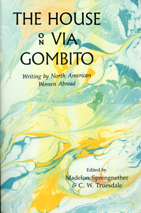Odd what moments stand out. When I look back on our excursion from Umbria south into Lazio (the Italian province which contains Rome), I find myself outside a church in Viterbo, gazing over the main piazza of the city. Just to my left, high against a stone wall, hangs the stone lion, guardian of the city. As we entered the square, I looked up at the lion (perhaps with a palm tree behind him) and commented, “Mi piace moltissimo il leone.” One of the group whom I scarcely knew, a tall man with soft Italian body, someone with a weight of sorrow on his back, spoke to me for the second time that afternoon: “Si, si, e molto gentile.” It was the surprise of his response, when I’d been rather diffident in his presence (he was, after all, reported to be a count), plus the charm of the grinning lion that cemented the moment in memory.
As tourists, it’s impossible not to be rather vague about where exactly, and how, and what’s to come next. We’re carried along by those who know–friends, in my case, or tour guides who treat us like friends. Landscape whizzes past. We stop to meander around ruins, examining the fiori di campo (literally field flowers), noting that they’re the same malva found among the Roman ruins in Umbria, stooping to pick up a piece of stone, numbered then discarded by archaeologists excavating this site of Roman/medieval baths, theater, etc. Being told by a restorer among us that every piece unearthed must be numbered, but since not all can be fit into a meaningful whole, ,many are left for curious scavengers to lift, finger, and once again discard.
Italy, with its rocky, hilly terrain, its centuries of wealth (often from outside the region) lording it over peasants, far more familiar with the land and seasons, crops and produce than those nominally in charge, is full of opportunities for such charming encounters. Little fragments numbered according to some other system than our own tumble suddenly into view. An American friend, entering Venice with her sister and a tour group, steps into a gondola and is wafted away by a gondolier singing an aria from Italian opera. Suddenly running toward them along the canal comes a woman with a cerise scarf floating behind her. She’s in full voice, offering to the world and the throaty gondolier, the female accompaniment to his role. Her husband, their friends, run after her and tug at her clothing. “Stop, stop,” they insist, but she breaks free and runs beside the gondola, as together, she and the gondolier complete the love duet. I can’t forget this, and it didn’t even happen to me.
Following association and memory through the labyrinth of Italian story, I find myself in a rocky field, on the huge island of Sardinia, off the western coast of Italy. Edging her way toward the stone hut of a goatherd is the youngest daughter of a wealthy, landlord family. The daughter, lonesome, cooped up by late 19th-century etiquette, by boredom and isolation, has found a friend. Perhaps she reads to the old man; or he tells her about his goats, his memories of her family years ago, his own children and wife lost to the years.
She grows up. There is a war. She moves to the mainland and sets aside afternoons to write while her own children sleep. This is Grazia Deledda and the novel containing this story is published as Cosima n 1937, the year after she has died. Though DeLedda won the Nobel prize for literature in 1926, very few of her works have been translated into English. We can thank Italica Press for bringing us a fine English translation of Cosima by Martha King.


Sharon Chmielarz
I found this a very interesting travel blog.